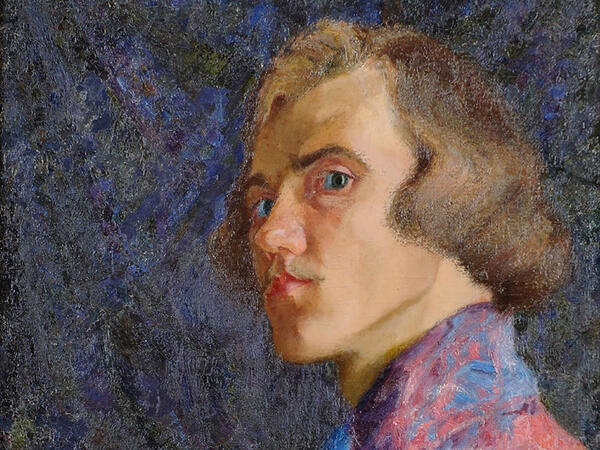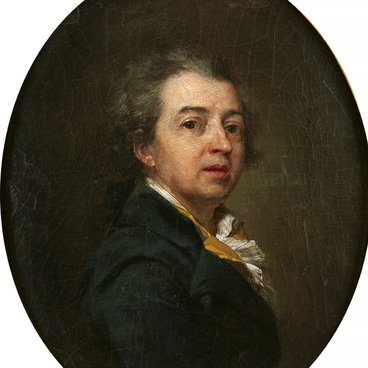In the early 20th century in Russia, artists were searching for new ways of artistic expression both the technique and the subjects of the paintings were changing. ‘Self-Portrait’ from the collection of the Chelyabinsk State Museum of Fine Arts was painted in an unusual manner and in a special ‘shimmering’ color palette. The artist imagines himself as if going through the prism of time: the young man depicted on the canvas outwardly resembles the characters of the 18th or 19th century, the periods which were the inspiration for Symbolist artists.
The artist who created this painting was Nikolay Rusakov. He was born in 1888 in the village of Pisklovo, the Chelyabinsk District, the Orenburg Governorate. In 1889 (according to other sources, in 1901), Rusakov and his family moved to Chelyabinsk, where in 1907, he graduated from a three-year city school. From 1909 to 1912, Nikolay Rusakov was a non-matriculated student of the Kazan Art School, then he finished the full course of the painting department. It was during these years that he created his self-portrait. After that, the artist taught drawing at the second city school in Kazan. In 1917, Rusakov graduated from the Moscow School of Painting, Sculpture and Architecture, where he studied in the class taught by Konstantin Korovin.
After the Bolshevik revolution, Nikolay Rusakov returned to Chelyabinsk. In the first half of the 1920s, he traveled to Central Asia, Northern Afghanistan and India. Art critic Galina Trifonova wrote about his hobby, ‘Nikolay Rusakov lived in color, it was his specialty. And his passion for the East played a special role in this. The book “Noah Noah” by Paul Gauguin had just been translated into Russian, and Rusakov followed the French artist to the East. At that time, art students often traveled — someone chose the countries of the West, someone went to the East. Rusakov chose the East’.
In his hometown, Rusakov organized a branch of the Artists’ Union of the USSR, where he was a director of a painting studio. Classes in the studio “Academy of Rusakov” were organized according to the program of the four-year course of the art school.
Rusakov became the first artist in Chelyabinsk to receive an education in Moscow. He painted landscapes, genre paintings, travel albums and propaganda posters.
In 1941, Nikolay Rusakov was arrested on a false denunciation by one of the students and sentenced to capital punishment — execution. He was posthumously rehabilitated in 1957.
The artist who created this painting was Nikolay Rusakov. He was born in 1888 in the village of Pisklovo, the Chelyabinsk District, the Orenburg Governorate. In 1889 (according to other sources, in 1901), Rusakov and his family moved to Chelyabinsk, where in 1907, he graduated from a three-year city school. From 1909 to 1912, Nikolay Rusakov was a non-matriculated student of the Kazan Art School, then he finished the full course of the painting department. It was during these years that he created his self-portrait. After that, the artist taught drawing at the second city school in Kazan. In 1917, Rusakov graduated from the Moscow School of Painting, Sculpture and Architecture, where he studied in the class taught by Konstantin Korovin.
After the Bolshevik revolution, Nikolay Rusakov returned to Chelyabinsk. In the first half of the 1920s, he traveled to Central Asia, Northern Afghanistan and India. Art critic Galina Trifonova wrote about his hobby, ‘Nikolay Rusakov lived in color, it was his specialty. And his passion for the East played a special role in this. The book “Noah Noah” by Paul Gauguin had just been translated into Russian, and Rusakov followed the French artist to the East. At that time, art students often traveled — someone chose the countries of the West, someone went to the East. Rusakov chose the East’.
In his hometown, Rusakov organized a branch of the Artists’ Union of the USSR, where he was a director of a painting studio. Classes in the studio “Academy of Rusakov” were organized according to the program of the four-year course of the art school.
Rusakov became the first artist in Chelyabinsk to receive an education in Moscow. He painted landscapes, genre paintings, travel albums and propaganda posters.
In 1941, Nikolay Rusakov was arrested on a false denunciation by one of the students and sentenced to capital punishment — execution. He was posthumously rehabilitated in 1957.


